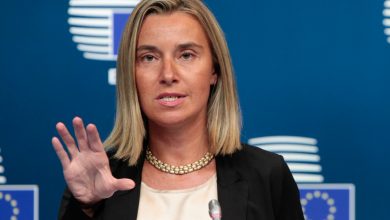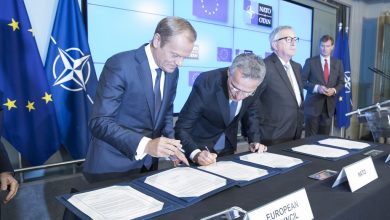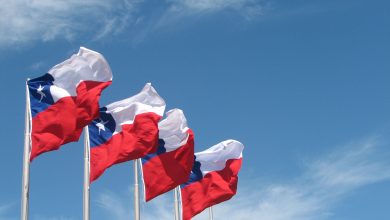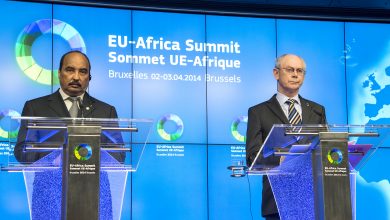The High Representative’s Role in the Iran Deal Through the Years

In July 2015, the parties involved in the negotiations over the Iranian nuclear capabilities reached an agreement putting an end to a years-long diplomatic effort. The P5+1 (France, United Kingdom, Russia, China, United States plus Germany) signed the Joint Comprehensive Plan of Action (JCPOA) with Iran. The deal consisted of the progressive lifting of sanctions imposed on Iran in exchange for the reduction of the number of gas centrifuges used for isotope separation and consequently the quantity of uranium produced. By following the development of the diplomatic efforts, we can easily trace the development of the role of High Representative of the Union for Foreign Affairs and Security Policy in these negotiations.
The Security Council of the United Nations issued the first sanctions concerning the Iranian nuclear program in 2006, following resolution 1696. The International Atomic Energy Agency (IAEA) had previously stated in a report that Iran was not following the rules of the Safeguards Agreement on uranium enrichment. After a first warning, the UN imposed sanctions due to Iran refusing to comply with said rules.
However, some countries had already begun talks with Iranian authorities in the early 2000s when it was already clear that Iran had set up a secret nuclear program for military purposes. With the Tehran Declaration of 2003 and the Paris Agreement of 2004, Germany, the United Kingdom, and France settled the matters momentarily through diplomatic efforts and an informal framework for the negotiations called E3. These three countries are the “lead group” or the “contact group” of the EU in this issue. Russia, China, and the United States later joined the framework and took part in the negotiations until an agreement was reached in 2015.
In mid-2004, the three European countries decided to involve the EU in the process to increase the political leverage vis-a-vis Iran. They opposed the involvement of the “foreign affairs troika” (the High Representative, the Council Presidency and the Commissioner for External Relations) as it would have enlarged the weight of bureaucracy in the negotiations.
Enter Solana: The First High Representative
They opted for the inclusion of the High Representative only, a post at the time occupied by the experienced Spanish diplomat Javier Solana. Such an alternative offered a good compromise: the general interest of the EU would be safeguarded through his presence, but the process would not suffer from the inclusion of additional Member States that could risk slowing down the pace of negotiations.
In the beginning, Italy was expected to take part in the joint framework as a major commercial partner. However, Prime Minister Silvio Berlusconi expressed concerns over the country’s economic relations with Iran and kept the government out of negotiations in spite of continuous bilateral talks with the Iranian authorities. Berlusconi also had strong ties with the Bush administration and did not want to displease Washington. Italy’s participation, however, would have been strongly welcomed by the Iranian authorities.
Javier Solana had a long diplomatic career behind him. He served as NATO Secretary General and as such supervised the Allied operations in the Balkans during the war in Kosovo, distinguishing himself by containing rivalries between Slavs and Albanians in Macedonia. Due to his previous experience with nuclear proliferation, as well as briefings by the E3 after every round of negotiations, he was deemed fit for the role the countries were entrusting him with.

The inclusion of the High Representative offered the E3 greater legitimacy and also access to the EU assets, although limited before the setting up of the External Action Service (EEAS). Solana had strong Atlanticist credentials but did not follow neoconservative thought. As a result, the United States, Russia, and China saw him as a moderate figure that could be trusted. He served as a bridge between the West and the two Asian powers also thanks to the personal network of contacts and relations cultivated during his tenure at the Spanish Ministry of Foreign Affairs and NATO.
It can be argued that the inclusion of Javier Solana boosted the image of the EU abroad as a united bloc. Indeed, the E3/EU group ended up representing all member states during the negotiations. While Germany, the United Kingdom, and France remained the main players behind the main discussing points of the deal, Solana played an important role in presenting a collective European position during the talks. Indeed, Solana embedded the figure of the High Representative in the negotiations and confirmed its importance for what concerns the representation of the EU at the international level.
Ultimately, the role of the High Representative before the inclusion of the US, China, and Russia was secondary. The E3 counted on the advice of Solana and his assistant Robert Cooper, but they did not shape the negotiations. The EU had to act as a united bloc when the number of participants increased and the HR constituted the added value needed in that situation.
Indeed, Solana often represented the E3 during the talks. For instance, he met with the chief negotiator Ali Larijani several times, representing the position of the EU as a whole. Solana had direct access to the foreign ministers of the E3 so that a common position could be agreed upon. In 2007, when negotiations stalled, he proposed a “double suspension” that would entail both, a momentary freeze of nuclear enrichment by Iran and the removal of sanctions by the P5+1.
The Lisbon Treaty and Catherine Ashton
With the ratification of the Lisbon Treaty in 2009, the High Representative became a double-hatted figure. The division of competences between Javier Solana and the Commissioner for External Relations had never been resolved before resulting in, at times, prominent conflicts and inter-institutional competition. The new reforms simplified the hierarchic structure and entailed the set up of a European diplomatic service (the EEAS). Ultimately, the High Representative also assumed the role of Vice-President of the Commission and became head of both the EEAS and the European Defence Agency (EDA).
With Catherine Ashton replacing the Spanish diplomat, the role of the High Representative in the negotiations changed slightly. Ashton did not possess the diplomatic skills of her predecessor but could count on the so-called “Iran people” working for the External Action Service. These officials briefed the High Representative before every round of negotiations so that she would have all the information needed at her disposal. Moreover, despite her different background, Lady Ashton had already dealt with issues concerning nuclear proliferation during her work for the Campaign for Nuclear Disarmament in the early Eighties.

Interestingly, Ashton had an excellent relationship with US Secretary of State John Kerry, who put much faith in her skills and considered her a fundamental asset for transatlantic relations on the issue. Indeed, the P5+1 decided to appoint her chief negotiator of the group after a decisive diplomatic move. When negotiations appeared on the verge of collapse, Ashton came up with the idea to include Mohammed Javad Zarif, Iran’s foreign minister, in the talks. Zarif had studied in the US in his youth and appeared more pro-West than other Iranian negotiators.
According to Alexander Graf Lambsdorff, a former member of the Committee on Foreign Affairs of the European Parliament, Ashton was “discrete and perceptive, but also tenacious. That makes her an ideal negotiator”. Therefore we can argue that, at a certain point, the role of the High Representative went beyond representation and became active in part of the negotiations.
The High Representative in the Mogherini Years
Following the 2014 European elections, the European Council appointed the Italian politician Federica Mogherini as High Representative. Mogherini continued the work of her predecessors and, like Lady Ashton, heavily relied on EU officials in the EEAS. The staff, especially Helga Schmid, the EU expert in charge of the nuclear dossier, helped coordinate the final rounds of negotiations in 2014 and 2015 and provided her with relevant insights.
Mogherini controlled the agenda and the time for plenary and bilateral meetings between delegations and had contacts with other parties such as Israel, Saudi Arabia, and US allies from Asia. Furthermore, Mogherini had a role in the wording of all versions of the deal. Helga Schmid closely collaborated with the US lead negotiator Undersecretary of State Wendy Sherman and both worked on the conflict resolution mechanism without consulting the European national negotiators first.
The institutional reforms set up under the Lisbon Treaty certainly helped the EU in forming a foreign policy apparatus that could finally provide the Union with the telephone number Henry Kissinger was looking for some decades earlier. The negotiations with the Iranian authorities gave the High Representative a chance to test the newly adopted reforms. While the Iranian delegation was skeptic over the actual power of the High Representatives, the EU acquired an enhanced significance in the eyes of the other powers by ditspatching its diplomats.
Unfortunately, though, these institutional reforms had limits. The Common Foreign and Security Policy still suffers to this day from the intergovernmental nature of the European Union. Initiatives by the High Representative only become the policy of the EU if the Council agrees under a qualified majority vote.
Initially, the communication between the E3 and other Member States ran exclusively through national officials. The foreign ministers or minor officials of the E3 informed their peers on the progression of the negotiations during the General Affairs and External Relations Council (GAERC) and the Political and Security Committee (PSC). When the High Representative stepped in, the HR was entrusted with said task.
The E3 and the HR decided not to involve other European institutions such as the Commission and the Council Presidency. While the Presidency was successfully kept out, it became difficult for the High Representative to retain the confidence of the Commission. First, the Lisbon Treaty made the HR vice-president of the Commission. Second, at the beginning of the nuclear talks, the Commission was negotiating a Trade and Cooperation Agreement with Iran. The Commission did not separate the two dimensions as they used the TCA as leverage.

It’s interesting to inquire into the relationship between the E3 and the High Representative and to understand how the overall EU foreign policy changed throughout the last years. In 2016, for instance, the European Union adopted the European Union Global Strategy, replacing the European Security Strategy laid out by Solana in 2003. Drawn up under the authority of the High Representative Federica Mogherini, the Strategy gives great importance to her role and the European diplomatic corps.
The document states that lead groups, now considered a useful framework to carry out foreign policy actions, can “implement agreed positions of the Council upon invitation by the HR”. This differs from the action plan automatically adopted when negotiations with Iran started in 2003, where the E3 acted independently of the High Representative. This recent approach, of course, does not attract the sympathy of big member states, which are extremely protective of their sovereignty when it comes to foreign policy.
During the negotiations and afterward, newspapers and academics writing about the nuclear negotiations started speaking of the EU and the E3 interchangeably. This element does definitely play in favour of the European Union and the Common Foreign and Security Policy, which embraced the “lead groups” formula in other occasions; for instance, the contact group for the Balkans (which included the US and Russia) and the Normandy Format framed by France and Germany after the Russian invasion of Crimea in 2014.
We can use the agenda-setting categories laid out by Princen (2011) to better understand the impact of the High Representative on the Iran deal and the previous negotiations. The categories are 1) Mobilizing Support, 2) Arousing Interest, 3) Building Capacity, and 4) Claiming Authority. The first two can be described by the strategy of “gaining attention”, while the latter two can be attributed to the strategy of “building credibility”. As the High Representative was invited by the E3, the first two categories fall short of importance in this case. Indeed, it was Germany, France, and the UK that mobilized the support for the HR and the EEAS, not vice versa. Moreover, the determination of the Iranian government to continue enriching uranium lead to an interest in urgent action.
However, once embedded in the framework of the negotiations the European Union, represented by its EEAS diplomats and the HR, gained visibility and became accepted as a full actor thanks to the organizational capacities at its disposal. As for “claiming authority”, the HR succeeded in doing so by relying on the expertise and reliability first provided by Javier Solana and then by the diplomats engaged with the nuclear dossier on Iran working for the External Action Service.
Conclusion
The EU has a long tradition of support for non-proliferation policies. Therefore, its dedication and interest in the negotiations with Iran should not come as a surprise. This case study offers an excellent opportunity to test the effectiveness of the EU’s foreign policy, especially as carried out by the High Representative. Indeed, all three HRs appointed to the post until now have dealt with the negotiations. Moreover, the effects of the Lisbon Treaty reforms can be observed through the new approach adopted starting from the tenure of Catherine Ashton in 2009 and the new capabilities provided by the External Action Service.
At the same time, there has also been a continuity in the way the EU representatives and negotiators carried out their duties. Based on the data available, the High Representative’s participation was not decisive, as the parties would have agreed to a deal even without the contribution of Solana, Ashton, and Mogherini. However, their presence helped enhance the stature of the EU on the world stage and made more difficult for the E3 to break ranks. Despite their limited significance, Solana and Ashton made smart diplomatic moves. Their network of contacts also helped the US and Europe present a united front to the Iranian delegation. During Trump’s presidency, this unity has been damaged by a diverging policy approach towards Iran.




